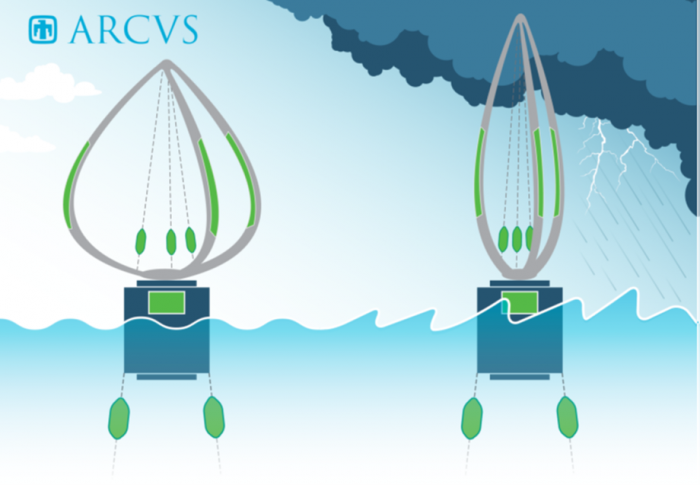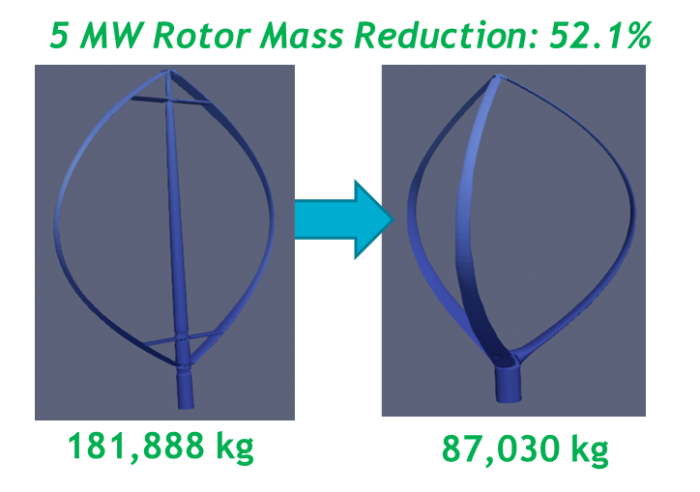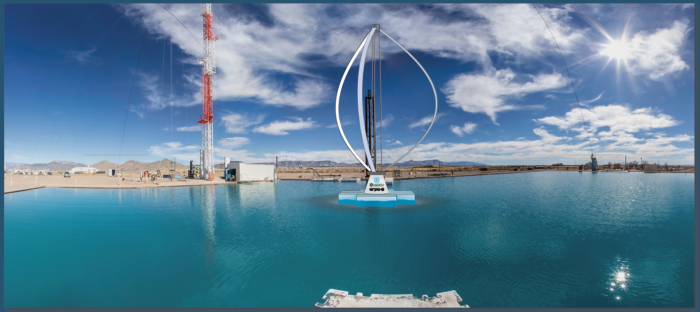The concept for the ARCUS vertical-axis wind turbine (VAWT) was developed in response to the ARPA-e ATLANTIS program call in 2019. This concept was designed to address the unique challenges for floating offshore wind energy in the U.S. where costs are 3-5 times higher than for land-based wind energy installations. Due to the high and complex system costs for floating offshore wind energy, the turbine represents only 20% of the levelized cost of energy (LCOE) compared to nearly 50% for land-based installations. The appropriate goal for the turbine in this application is to reduce not only its capital costs, but the capital and operational costs of the entire system.
ARCUS is a towerless VAWT that replaces the traditional rigid tower with pre-stressed blades and tensioned center supports (U.S. patent 11,421,650 B2), like a bow, which:
- Enables a structurally efficient usage of turbine material
- Enables rotor area control for high wind speed load reduction
- Effectively enables tension-leg platforms (TLP) which have the lowest hull mass compared to alternative architectures
- Produces an estimated $55/MWh LCOE for the optimized system

Sandia worked with its partners, FPS Engineering & Technology and the American Bureau of Shipping, to develop the conceptual system design through component and system design optimization studies to exploit the complicated system cost-performance tradeoffs for floating offshore wind energy. A 22MW ARCUS turbine was designed with an optimal tension-leg platform, producing a system LCOE estimate of $55/MWh. The identified ARCUS-TLP system is illustrated in Figure 1, based on the system design optimization results. The competitive $55/MWh LCOE results from the synergistic combination of fundamental VAWT advantages (e.g., the lower center of gravity) in combination with the ARCUS structural efficiency and area control that decreases the mass and overturning moment which pairs well with the tension-leg floating platform, having its own characteristic material efficiencies.

The ARCUS-TLP LCOE is compared to an estimate for a floating offshore horizontal axis wind turbines (HAWT) in the U.S. This reference HAWT system represents an 8 MW HAWT on a semi-submersible platform with an installation water depth of 739 m (Stehly & Duffy, 2021), and was chosen due to the availability of the detailed LCOE cost breakdown for comparison, shown in Figure 2. In addition to an overall LCOE reduction (displayed as the area of the pie charts), there are some notable distinctions in the distribution of the LCOE for the ARCUS-TLP. Each of the cost components for the ARCUS-TLP system is reduced on an absolute scale ($/MWh), but there are also percentage reductions within the distribution for the Turbine & Integration and Operations & Maintenance (O&M) categories for the VAWT system. The relative decrease in O&M costs is a result of the increase in energy production for the ARCUS system design, which scales these costs. The lower relative turbine cost component for the ARCUS design results from the efficient material utilization where the steel tower is eliminated, and where the drivetrain support structure is integrated into the platform (reducing the amount of additional material required for the “nacelle” type support).

The LCOE of the ARCUS-TLP system is compared to additional research and industry estimates for floating HAWT systems at various sites in Figure 3. There is a wide range of estimates for this emerging industry based on site conditions, but it is apparent that the ARCUS system enables a shifted cost timeline relative to existing technologies. The ARCUS system enables the LCOE of a mature floating offshore wind industry to be realized in the near-term, progressing the cost curve by 10 or more years. Continued development of traditional HAWT designs without reassessing the unique design and cost drivers for the floating application may hinder the industry growth of floating offshore wind in the U.S. and globally.

Prior VAWT designs have been shown to have a lower center of gravity than HAWTs but were also more massive and typically estimated to be more expensive, relying purely on platform and balance of system cost reductions to reduce the LCOE. The ARCUS concept was developed and studied to overcome this characteristic and reduce the mass and cost of the turbine itself relative to HAWT designs. HAWT designs are optimal in several ways, where the blade length is the radius of the swept area and therefore blades are relatively light compared to their swept area. A major challenge for HAWTs is that most of the turbine weight exists simply to support the rotor and drivetrain, up to 75% of the total weight, and that controlling the mass properties is increasingly challenging with turbine scaling. As HAWTs increase in size, the drivetrain becomes more massive and at a higher elevation which requires exponentially more steel for support and challenges the tower design.
Through this project the ARCUS design was compared to a reference HAWT with a nearly equivalent swept area, revealing the following benefits:
- 70% lower center of gravity
- 30% reduction in the turbine mass
- The low drivetrain placement allows for a larger generator than is optimal for a horizontal-axis wind turbine, enabling 45% more energy capture for the same swept area
- The low drivetrain placement and mass properties of the ARCUS VAWT make it optimally suited for a tension-leg platform, identified as a cost-optimal platform architecture with additional performance benefits
Prior to producing the final ARCUS design at the 22MW scale, a study was performed to quantify the mass savings potential of the ARCUS towerless VAWT. A traditional 5MW Darrieus VAWT with two blades was used as the reference from earlier work at Sandia (Ennis & Griffith, 2018). The ARCUS concept was compared at this scale having the same swept area and was designed using an operational load case with extreme turbulence levels, representing the highest operational loads. As an additional control, the airfoil type and placement for the ARCUS design was equated to the reference VAWT design. Two analyses were compared for the ARCUS system where (1) the blades were manufactured straight and bent into the operational shape or (2) the blades were assumed to be manufactured in their bent shape. The curved blades were seen to outperform the straight blades, having a lower mass, but this manufacturing approach was not chosen due to the anticipated challenges with manufacturing and transportation of curved blades. The straight blades that are prestressed into the operational shape had a slight mass penalty but were still observed to outperform the towered Darrieus VAWT with over a 50% rotor mass reduction for the ARCUS system. This mass savings was even observed when going from a two-blade to three-blade design for the ARCUS rotor, which typically increases the total blade mass. The ARCUS design uses three blades to provide additional resistance to deflection of the upper blade hub and adds the additional benefits of reducing the magnitude of cyclical load variation within a revolution and improving the self-starting capability of the VAWT.

The project focused on a tension-leg platform as the floating platform architecture for the study system based on earlier findings compared to alternative platform architectures revealing the cost and performance benefits when paired with a VAWT (Ennis & Griffith, 2018). In this project, the fundamental configuration of the TLP hull began as an unknown and was identified through producing a survey of TLP designs and concepts and assessing the most promising configurations to compare mass and cost. The project team established design requirements to simplify the installation process, including quayside turbine integration with a draft of less than 10m and self-stability during tow-out of the integrated system. These design constraints and the characteristic loads of VAWTs resulted in identification of a three column TLP with leg extensions as the optimal system to reduce capital costs while enabling the simplified installation and suitability to ports in the U.S. The selection process is illustrated in Figure 5, with the optimal system configuration shown on the right.
The project team designed a TLP that was optimized for the reduced mass properties of the ARCUS VAWT with the following characteristics:
- Simplified installation without requiring specialized vessels, satisfying the following constraints:
- Quayside turbine-platform integration with a 10m draft
- Self-stable during tow-out with integrated turbine
- An optimal three column TLP hull architecture with leg extensions was identified through discrete design studies that minimized mass while meeting the design requirements
- Ideally suited for shallow or deep-water sites in the U.S., scalable to beyond 1000 m
- Vertical tendons have a narrow footprint which simplifies the subsurface and seabed relative to catenary mooring systems, maximizing ocean co-use and reducing unwanted environmental impacts
- Received an “Approval in Principle” certificate from the American Bureau of Shipping

Detailed design studies were performed for the ARCUS-TLP system including global performance analysis and a minimum scantling structural design, with results shown in Figure 6. These tasks produced a baseline platform configuration with volumetric mass relationships for eleven regions of the platform hull, which were used in the optimization studies to optimize from the baseline design for variable turbine loads and mass. Prior to this project, the bearing loads and design for VAWT systems had a high level of uncertainty. The loads carried through the drivetrain bearings for VAWTs are fundamentally different than for HAWTs. For VAWTs, the bearings carry aerodynamic loads radially versus axially for HAWTs. Similarly, gravitational loads from the weight of the turbine are carried axially in the bearings for VAWTs compared to radially for HAWTs. Not only is the loading orientation shifted, but the center of pressure of the aerodynamic loads is at a high elevation away from realistic bearing locations resulting in radial bearing loads that are amplified and can be 6-8 times the maximum thrust force for relatively short bearing spacing configurations. These high radial loads affect the bearing design and the support structure design that houses the bearings. The impact of the large radial bearing loads on the support structure was assessed within this project’s structural analysis work through studying the opportunity for housing the drivetrain within the primary platform column. This design approach has two advantages to efficiently reuse the existing material in the column and to further reduce the center of gravity through lower placement of the drivetrain. It was found that the existing structure of the primary column required to satisfy the global loads needed only minor modification to withstand the radial bearing loads and provides an overall mass savings from other approaches where the turbine support would be located above the column freeboard.
The result of the detailed design studies for the TLP coupled to the ARCUS turbine revealed the synergies for this system, including these findings:
- The total hull steel weight of 3030 tonnes is low relative to existing platforms designed for HAWTs (0.033 tonnes/MWh/year, 136 tonnes/MW) (Singhal, Connolly, Laranjinha, MiKinnon, & Mortimer, 2021)
- The VAWT drivetrain can be housed within the hull’s primary column, efficiently utilizing the existing steel without significantly affecting the platform mass requirements
- Yaw deflections remain under 10 degrees in response to the VAWT generator torque and are not problematic for the system design or tendon connectors
- Optimization studies revealed the opportunity to utilize platform hull asymmetry to further reduce the platform mass requirements based on the off-centered turbine load

Remaining Research & Development Needs
The towerless ARCUS vertical-axis wind turbine concept and design methodology enables the competitiveness of floating offshore wind through unprecedented reductions in turbine mass properties with low drivetrain placement and efficient material usage. The topside mass savings further result in platform mass savings and enable tension-leg platforms, greatly reducing the system capital costs and resulting in a competitive levelized cost of energy estimate of $55/MWh. The system-level design process and control co-design optimization ensures that cost-performance tradeoffs have been exploited, but challenges remain with introducing a radically new design concept to market. The continued progress of this technology and possibility of a U.S.-based VAWT manufacturer rely on funding agencies and investors willing to accept the risk of a low technology readiness level (TRL) concept that can accelerate a sustained deployment of floating offshore wind energy in the U.S.
The project team has developed a project plan to enable and accelerate the commercial deployment of the ARCUS vertical-axis wind turbine and tension-leg platform system at utility-scale power production. By the end of the plan, the outcome is a commercially viable system (platform front end engineering and design; functional turbine prototype achieving a TRL=6) with manufacturing and installation processes detailed.
Commercial development objectives can be accelerated through five primary work packages:
- Higher certainty design optimization studies
- Quantification of commercial challenges and opportunities
- Design validation of the ARCUS-TLP system in a wind-wave basin
- Design validation of the ARCUS turbine at a >100kW scale
- Partnering for commercialization
Sandia and the project team are actively looking for partners to join in bringing this innovative technology to market through commercial design optimization studies and demonstration at meaningful scales, as illustrated in Figure 7.
